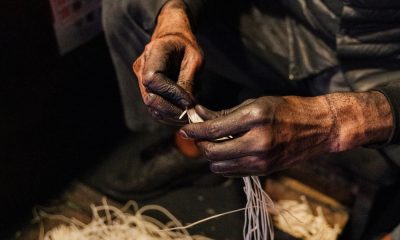Business
Thank God for noodles. R-amen!
We all love ramen, but what’s it like to set up shop in the industry? KS caught up with Hiroshi Miyashima, a true master of the art and owner of Osaka’s own specialist ramen school, to find out the dos and don’ts.
Kansai Scene: Just how important is it to use the best ingredients in ramen?
Hiroshi Miyashima: Extremely. The building blocks of ramen are the noodles themselves so it is imperative that you do them right first and foremost. It’s a matter of using quality flour but also researching about the flour and treating it appropriately. Using quality meat and vegetables for the broth will also prove influential when it comes to satisfying your customers and lining your pockets, so never give in to the temptation to be stingy!
KS: What are the main obstacles when opening and maintaining a ramen shop?
HM: Ninety-nine times out of a hundred, good ramen shops never become well known, but bad ramen shops become (in)famous very quickly. A common mistake among unsuccessful ramen chefs is that they concentrate too much on making ramen that they themselves like with the assumption that because they like it, so too will others. This is not necessarily the case in a country where there are so many different regional variations and preferences. Wherever you plan to open your ramen business, I can’t stress enough how important it is to get to know your customer base ahead of time through market research. Another big problem, in Japan anyway, is that there are so many ramen shops. The market is saturated in salty broth!
KS: So with there being so many different types of ramen, which would you advise foreigners to make when opening a shop abroad?
HM: I think tonkotsu (pork bone broth) ramen is the best bet for foreigners trying to make it abroad. In my experience, non-Japanese typically take to this type very quickly. My advice in this case, however, would be that if you’re trying to introduce ramen in your home country, education is key. Explain to your customers what ramen is, where it came from and what it’s about in order to garner curiosity.
KS: How can one make one’s ramen establishment stand out from the crowd?
HM: It’s not about the bowl of ramen, it’s about the ramen restaurant as a whole. Making your food delicious is unfortunately only 10% of the battle. The other 90% comes from the place itself. I always liken it to AKB48… there are so many girls in that group that, for the most part, it’s difficult to tell one from another. However, the ones that you do remember are the ones that have special charm and something slightly different about them. It’s the same with ramen; customer service, ambience, even resorting to gimmicks, do anything and everything to make your place stand out.
KS: So what kind of person does it take to be successful in the ramen game?
HM: Ramen is very rewarding but also very hard work, so one has to be industrious and passionate. Also you’ve got to be on the ball and constantly evolving to keep up with the ramen trends coming out of Tokyo.
KS: Any other advice for foreigners thinking of starting up a ramen business?
HM: As I said before, the food is only a small part of the battle so be smart. Invest in technology to cut down the time you spend cooking so you can concentrate more on making your restaurant stand out. Also, however tempting it may be, don’t eat ramen every day or you will notice it when you try to put on that pair of pants that fitted you last month!
[box]
If you fancy learning more about making ramen, a one day crash course or a more intensive 2-3 week super ramen course can be booked at: www.ramenadventures.com/p/osakaramen-school.html
[/box]



















